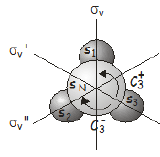12.5: The \(C_{3V}\) Point Group
- Page ID
- 210891
The first thing we need to do before we can construct a matrix representation is to choose a basis. For \(NH_3\), we will select a basis \(\begin{pmatrix} s_N, s_1, s_2, s_3 \end{pmatrix}\) that consists of the valence s orbitals on the nitrogen and the three hydrogen atoms. We need to consider what happens to this basis when it is acted on by each of the symmetry operations in the \(C_{3v}\) point group, and determine the matrices that would be required to produce the same effect. The basis set and the symmetry operations in the \(C_{3v}\) point group are summarized in the figure below.

The effects of the symmetry operations on our chosen basis are as follows:
\[\begin{array}{ll} E & \begin{pmatrix} s_N, s_1, s_2, s_3 \end{pmatrix} \rightarrow \begin{pmatrix} s_N, s_1, s_2, s_3 \end{pmatrix} \\ C_3^+ & \begin{pmatrix} s_N, s_1, s_2, s_3 \end{pmatrix} \rightarrow \begin{pmatrix} s_N, s_2, s_3, s_1 \end{pmatrix} \\ C_3^- & \begin{pmatrix} s_N, s_1, s_2, s_3 \end{pmatrix} \rightarrow \begin{pmatrix} s_N, s_3, s_1, s_2 \end{pmatrix} \\ \sigma_v & \begin{pmatrix} s_N, s_1, s_2, s_3 \end{pmatrix} \rightarrow \begin{pmatrix} s_N, s_1, s_3, s_2 \end{pmatrix} \\ \sigma_v' & \begin{pmatrix} s_N, s_1, s_2, s_3 \end{pmatrix} \rightarrow \begin{pmatrix} s_N, s_2, s_1, s_3 \end{pmatrix} \\ \sigma_v'' & \begin{pmatrix} s_N, s_1, s_2, s_3 \end{pmatrix} \rightarrow \begin{pmatrix} s_N, s_3, s_2, s_1 \end{pmatrix} \end{array} \label{10.1}\]
By inspection, the matrices that carry out the same transformations are:
\[\begin{array}{ll} \Gamma(E) & \begin{pmatrix} s_N, s_1, s_2, s_3 \end{pmatrix}\begin{pmatrix} 1 & 0 & 0 & 0 \\ 0 & 1 & 0 & 0 \\ 0 & 0 & 1 & 0 \\ 0 & 0 & 0 & 1 \end{pmatrix} = \begin{pmatrix} s_N, s_1, s_2, s_3 \end{pmatrix} \\ \Gamma(C_3^+) & \begin{pmatrix} s_N, s_1, s_2, s_3 \end{pmatrix} \begin{pmatrix} 1 & 0 & 0 & 0 \\ 0 & 0 & 0 & 1 \\ 0 & 1 & 0 & 0 \\ 0 & 0 & 1 & 0 \end{pmatrix} = \begin{pmatrix} s_N, s_2, s_3, s_1 \end{pmatrix} \\ \Gamma(C_3^-) & \begin{pmatrix} s_N, s_1, s_2, s_3 \end{pmatrix} \begin{pmatrix} 1 & 0 & 0 & 0 \\ 0 & 0 & 1 & 0 \\ 0 & 0 & 0 & 1 \\ 0 & 1 & 0 & 0 \end{pmatrix} = \begin{pmatrix} s_N, s_3, s_1, s_2 \end{pmatrix} \\ \Gamma(\sigma_v) & \begin{pmatrix} s_N, s_1, s_2, s_3 \end{pmatrix} \begin{pmatrix} 1 & 0 & 0 & 0 \\ 0 & 1 & 0 & 0 \\ 0 & 0 & 0 & 1 \\ 0 & 0 & 1 & 0 \end{pmatrix} = \begin{pmatrix} s_N, s_1, s_3, s_2 \end{pmatrix} \\ \Gamma(\sigma_v') & \begin{pmatrix} s_N, s_1, s_2, s_3 \end{pmatrix} \begin{pmatrix} 1 & 0 & 0 & 0 \\ 0 & 0 & 1 & 0 \\ 0 & 1 & 0 & 0 \\ 0 & 0 & 0 & 1 \end{pmatrix} = \begin{pmatrix} s_N, s_2, s_1, s_3 \end{pmatrix} \\ \Gamma(\sigma_v'') & \begin{pmatrix} s_N, s_1, s_2, s_3 \end{pmatrix} \begin{pmatrix} 1 & 0 & 0 & 0 \\ 0 & 0 & 0 & 1 \\ 0 & 0 & 1 & 0 \\ 0 & 1 & 0 & 0 \end{pmatrix} = \begin{pmatrix} s_N, s_3, s_2, s_1 \end{pmatrix} \end{array} \label{10.2}\]
These six matrices therefore form a representation for the \(C_{3v}\) point group in the \(\begin{pmatrix} s_N, s_1, s_2, s_3 \end{pmatrix}\) basis. They multiply together according to the group multiplication table and satisfy all the requirements for a mathematical group.
Contributors
Claire Vallance (University of Oxford)

